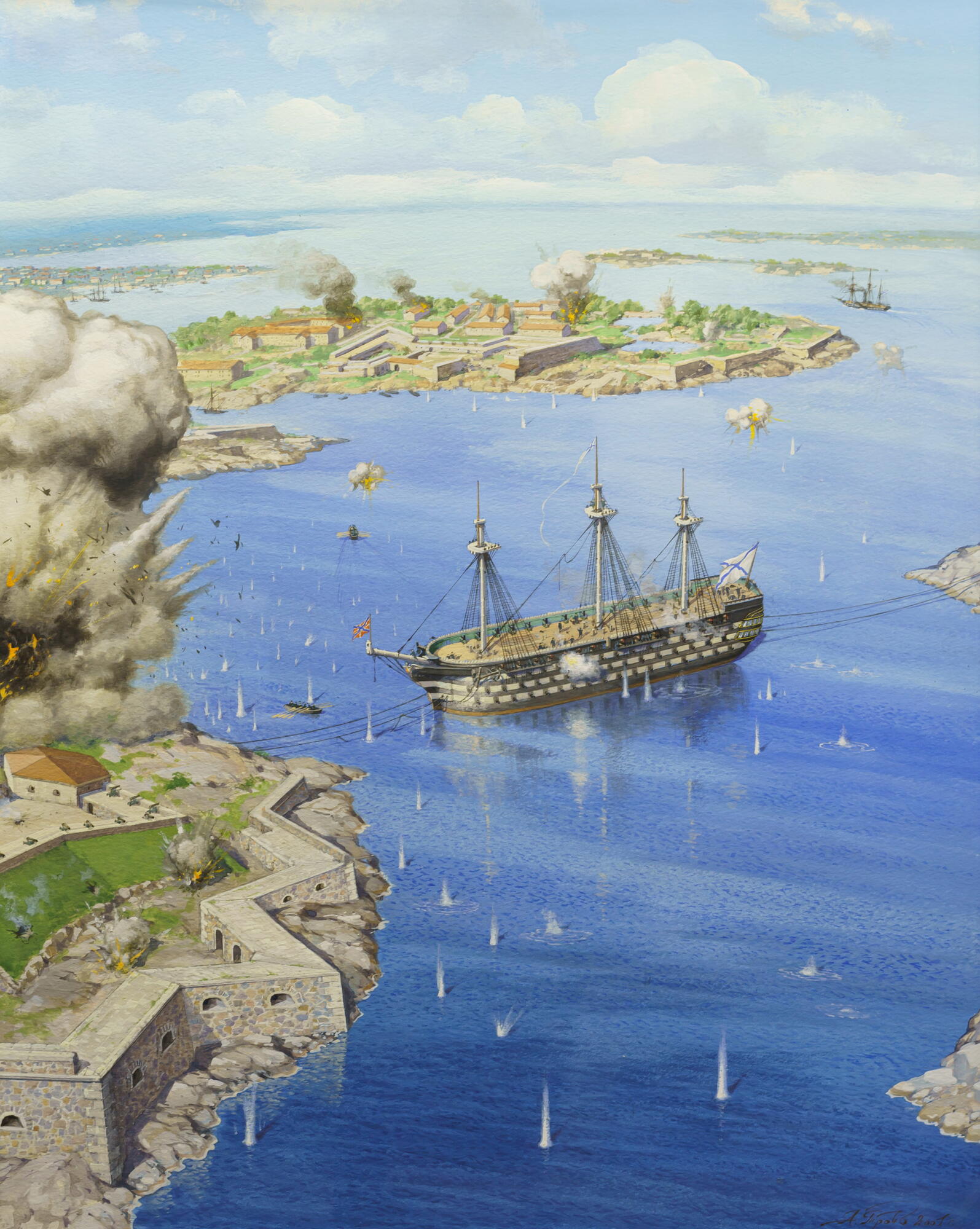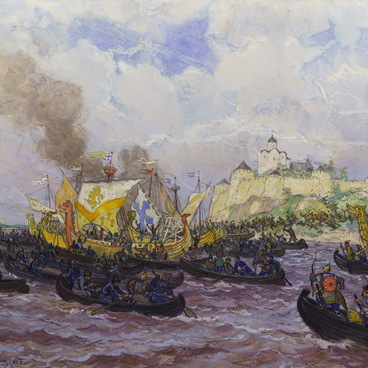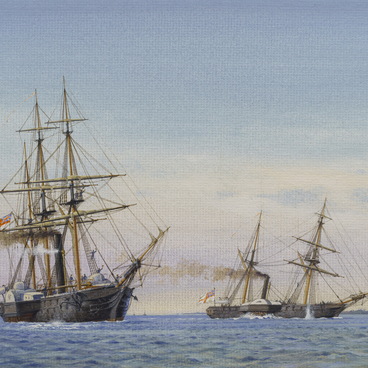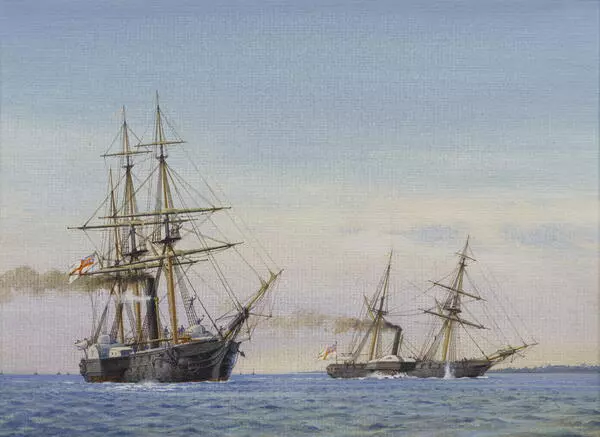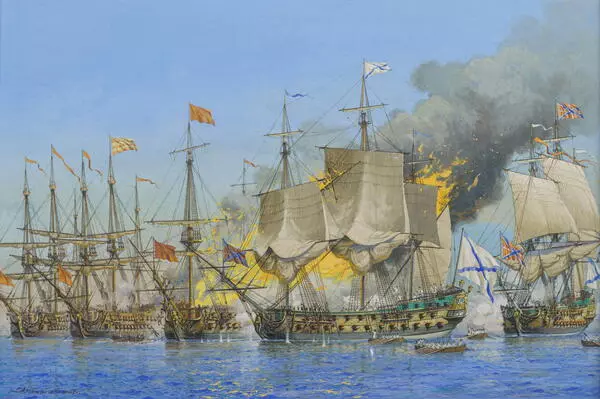During the Crimean (Eastern) War of 1853–1856, the British and French Fleet returned to the Baltic Sea in the spring of 1855 after withdrawing in the summer of 1854. During that time, the defenses of Kronstadt and Sveaborg were fortified. The allied squadron sailed to Kronstadt, but three of its scout steamers blew up after hitting mines, and the allies decided not to attack the fortress. Instead, they chose to wait for their gun and mortar boats to arrive and then storm Sveaborg.
On the morning of July 28, 1855, the allies started bombing the fortress. The British and French squadron consisted of 9 ships of the line, 5 frigates, 1 corvette, 21 floating batteries, 22 mortar and gun boats, 9 steamers, and 4 cargo vessels. Maintaining a position of 20–30 cable’s lengths from the fortifications (1 cable’s length being equal to 185.2 m), the squadron started the bombardment of the fortress that lasted for two days with only short breaks. The attack was retaliated by the Russian coast batteries as well as the ships that were anchored in the passages between the islands. These included 3 ships of the line, 1 frigate, 1 steam frigate, 1 schooner, and 5 gun boats. The allies had 1,000 pieces of artillery while Russia had around 300. Over 45 hours of battle, the allies fired 18,500 shells and around 700 incendiary rockets. The projectiles and fires that broke out because of them destroyed numerous wooden structures. However, the fortifications and batteries mounted on them suffered insignificant damage. In the Russian fleet, the “Rossiya” ship was the one that sustained the most damage while maintaining its position in the Gustafsvard passage: it suffered 85 shot holes, while 11 members of the crew were killed, and 89 were wounded.
The “Rossiya” 120-gun ship was laid down on February 11, 1836 in the New Admiralty Shipyard in Saint Petersburg and first launched in 1839. The same year, she joined the Baltic Fleet. She displaced 4,904 tons and had a length of 63.3 m, and a width of 17 m. At various times, “Rossiya” had between 120 and 128 guns.
In the 1854 and 1855 campaigns during the Crimean War, the ship was on standby in Sveaborg as part of the 3rd division of Vice Admiral Yakov Ananyevich Shikhmanov. During the bombardment of Sveaborg by the British and French fleet, the ship maintained its position in the Gustafsvard passage and delivered retaliation fire. On the night of July 29, 1855, “Rossiya” changed its position, but the enemy did not attack after that. After two days of bombing, the allied fleet withdrew.
After 1857, the “Rossiya” ship was used as a berthing barge in Sveaborg, and in 1860, it was decommissioned and sold for scrap.
On the morning of July 28, 1855, the allies started bombing the fortress. The British and French squadron consisted of 9 ships of the line, 5 frigates, 1 corvette, 21 floating batteries, 22 mortar and gun boats, 9 steamers, and 4 cargo vessels. Maintaining a position of 20–30 cable’s lengths from the fortifications (1 cable’s length being equal to 185.2 m), the squadron started the bombardment of the fortress that lasted for two days with only short breaks. The attack was retaliated by the Russian coast batteries as well as the ships that were anchored in the passages between the islands. These included 3 ships of the line, 1 frigate, 1 steam frigate, 1 schooner, and 5 gun boats. The allies had 1,000 pieces of artillery while Russia had around 300. Over 45 hours of battle, the allies fired 18,500 shells and around 700 incendiary rockets. The projectiles and fires that broke out because of them destroyed numerous wooden structures. However, the fortifications and batteries mounted on them suffered insignificant damage. In the Russian fleet, the “Rossiya” ship was the one that sustained the most damage while maintaining its position in the Gustafsvard passage: it suffered 85 shot holes, while 11 members of the crew were killed, and 89 were wounded.
The “Rossiya” 120-gun ship was laid down on February 11, 1836 in the New Admiralty Shipyard in Saint Petersburg and first launched in 1839. The same year, she joined the Baltic Fleet. She displaced 4,904 tons and had a length of 63.3 m, and a width of 17 m. At various times, “Rossiya” had between 120 and 128 guns.
In the 1854 and 1855 campaigns during the Crimean War, the ship was on standby in Sveaborg as part of the 3rd division of Vice Admiral Yakov Ananyevich Shikhmanov. During the bombardment of Sveaborg by the British and French fleet, the ship maintained its position in the Gustafsvard passage and delivered retaliation fire. On the night of July 29, 1855, “Rossiya” changed its position, but the enemy did not attack after that. After two days of bombing, the allied fleet withdrew.
After 1857, the “Rossiya” ship was used as a berthing barge in Sveaborg, and in 1860, it was decommissioned and sold for scrap.
